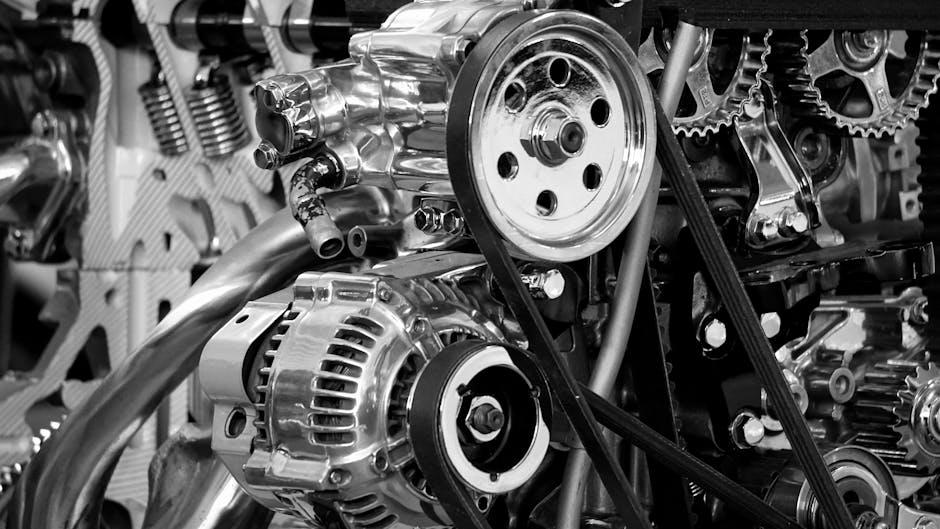Imagine cruising down the highway, the hum of the engine a steady companion, when suddenly your car’s transmission begins to slip—gears hesitate, power falters, and control feels fleeting. A slipping transmission isn’t just an inconvenience; it’s a warning sign that something beneath the surface needs urgent attention. Whether you’re a seasoned driver or new to vehicle care, understanding how to recognize transmission slipping and knowing the right steps to take can save you from costly repairs and keep your journey smooth. In this article, we’ll explore what transmission slipping means, why it happens, and, most importantly, what you should do if you find yourself in this slippery situation.
Table of Contents
- Understanding the Signs and Symptoms of Transmission Slipping
- Common Causes Behind Transmission Slippage and How to Identify Them
- Immediate Steps to Take When You Notice Transmission Slip
- Evaluating Whether to Repair or Replace Your Transmission
- Maintenance Tips to Prevent Transmission Slippage in the Future
- When to Seek Professional Help and What to Expect from Repairs
- Q&A
- Future Outlook

Understanding the Signs and Symptoms of Transmission Slipping
When your transmission starts slipping, your vehicle’s performance can suddenly become unpredictable and even unsafe. You might notice a delay in acceleration despite pressing the gas pedal, or the engine may rev higher without a corresponding increase in speed. Other signs include strange noises such as grinding or whining, and a jerking sensation as the gears fail to engage properly. These symptoms often occur during gear shifts, and they can worsen over time, signaling internal wear or fluid issues within the transmission system.
Be on the lookout for these key symptoms, which serve as red flags for slipping transmission:
- Delayed gear engagement: Hesitation before the car moves when shifting into drive or reverse.
- Unusual noises: Grinding, whining, or clunking sounds during acceleration or gear shifts.
- Burning smell: A distinct, acrid odor might indicate overheating transmission fluid.
- Transmission fluid leaks: Visible red or brown fluid pooling beneath your vehicle.
- Erratic shifting: Sudden changes between gears without warning or slipping between gear ratios.
| Symptom | What It Suggests |
|---|---|
| Delayed Engagement | Possible low transmission fluid or worn bands |
| Gear Slippage | Worn clutch plates or torque converter issues |
| Burning Smell | Overheated transmission fluid |
| Loud Noises | Damaged gears or fluid contamination |

Common Causes Behind Transmission Slippage and How to Identify Them
Transmission slippage often stems from a handful of familiar mechanical and maintenance issues. One common culprit is worn clutches or bands inside the transmission, which lose their grip over time, causing gears to slip unexpectedly. Another frequent cause is low or degraded transmission fluid, which compromises lubrication and hydraulic pressure, leading to delayed or incomplete gear engagement. Additionally, dirty filters or clogged fluid passages inhibit the smooth operation of the internal components, further contributing to slippage symptoms.
Recognizing transmission slippage early can save you from costly repairs down the road. Watch out for these telltale signs:
- RPM rises without acceleration, as the engine spins faster but the car doesn’t respond accordingly.
- Delayed or rough gear shifts, where the vehicle hesitates before changing gears or shifts harshly.
- Burning smell or unusual noises from the transmission, indicating overheating or worn parts.
- Fluid leaks visible under the car or on transmission components.
| Cause | Common Symptoms | Recommended Action |
|---|---|---|
| Worn Clutches/Bands | Gear slipping, loss of power | Professional clutch replacement |
| Low/Dirty Fluid | Delayed shifts, overheating | Flush and refill transmission fluid |
| Clogged Filters | Poor shift quality, noises | Filter replacement and fluid service |

Immediate Steps to Take When You Notice Transmission Slip
When a transmission starts to slip, immediate attention can prevent further damage and costly repairs. First, safely pull over and avoid driving the vehicle if possible. Continuing to drive under these conditions can worsen the problem. Next, check your transmission fluid level and condition. Low or dirty fluid is a common culprit behind slipping transmissions. If the fluid is low, top it up with the recommended type, but if it looks burnt or gritty, it’s best to schedule a professional fluid change soon. Also, make a note of any unusual symptoms like strange noises, delayed gear engagement, or jerking movements, as these details will be invaluable for your mechanic during diagnosis.
Here are immediate actions to consider:
- Stop driving at the first sign of trouble to avoid further damage.
- Check transmission fluid level and quality using the dipstick.
- Note any unusual behaviors such as slipping during acceleration or delayed gear shifts.
- Contact a trusted mechanic to arrange a diagnostic inspection.
| Symptom | Immediate Action |
|---|---|
| Delayed Gear Engagement | Stop vehicle and check fluid level |
| Burning Smell | Turn off engine and avoid driving |
| Jerking or Shaking | Drive slowly to a safe place and inspect fluid |

Evaluating Whether to Repair or Replace Your Transmission
When faced with a slipping transmission, the decision to repair or replace hinges on several crucial factors. First, consider the age and mileage of your vehicle. If your transmission has a history of repairs and the car has high mileage, replacement might be a more cost-effective choice in the long run. Meanwhile, if the slip is caused by minor issues such as low transmission fluid or worn-out seals, repair could restore performance without breaking the bank.
To help assess your options, weigh these points carefully:
- Extent of damage: Internal mechanical failure often requires replacement.
- Cost comparison: Repairs can be cheaper upfront, but may recur.
- Warranty considerations: New transmissions often come with better warranties.
- Vehicle value: Investment should align with the car’s current worth.
| Factor | Repair | Replacement |
|---|---|---|
| Cost | Lower, short-term fix | Higher, but long-lasting |
| Longevity | Potentially limited | Extended lifespan |
| Warranty | Usually limited | Often comprehensive |

Maintenance Tips to Prevent Transmission Slippage in the Future
Preventing transmission slippage begins with consistent and proactive care. One of the most effective steps is to regularly check and change transmission fluid. Transmission fluid lubricates the intricate gears and ensures smooth operation; dirty or low fluid levels increase the risk of slippage and costly repairs. It’s also wise to use the manufacturer-recommended type of fluid, as incompatible fluids can degrade seals and internal components. Along with fluid care, inspect your transmission system visually and listen for unusual noises—signs like burning smells or grinding could indicate early problems.
Implementing simple habits can strengthen your transmission’s health over time. Avoid harsh driving behaviors such as sudden acceleration, towing beyond your vehicle’s capacity, and frequent stop-and-go traffic. Additionally, allow your transmission to warm up during cold starts, especially in colder climates, to ensure optimal fluid flow. Reviewing your maintenance against the schedule below can help keep slippage well at bay:
| Maintenance Task | Frequency | Benefits |
|---|---|---|
| Transmission Fluid Check | Every 30,000 miles | Prevents overheating and wear |
| Transmission Fluid Replacement | Every 60,000 miles | Ensures smooth gear shifts |
| Transmission Filter Change | Every 60,000 miles | Filters out debris and contaminants |
| Drive Behavior Review | Ongoing | Reduces stress on transmission parts |

When to Seek Professional Help and What to Expect from Repairs
Recognizing when it’s time to bring your vehicle to a professional can save you from extensive damage and hefty repair bills. If your transmission slips regularly, exhibits delayed or rough shifting, or if warning lights appear on your dashboard, these are clear indicators that expert intervention is necessary. Attempting to diagnose or repair transmission issues without proper knowledge can often worsen the problem, so don’t hesitate to consult a certified mechanic at the first sign of trouble.
When you take your car in for repair, you can expect a thorough diagnostic process that may include road tests, fluid analysis, and electronic system checks. Professionals will identify whether the slip is due to simple causes like low transmission fluid or more complex issues such as worn clutch plates or valve body malfunctions. Common repairs might involve:
- Fluid changes or flushes to restore proper lubrication.
- Seal replacements for any leaks found.
- Rebuilding or replacing transmission components if significant wear or damage is detected.
| Issue | Typical Repair | Expected Timeframe |
|---|---|---|
| Low Transmission Fluid | Fluid Top-Up or Flush | 1-2 Hours |
| Worn Seals | Seal Replacement | 2-4 Hours |
| Clutch or Gear Damage | Component Rebuild or Replacement | 1-3 Days |
Q&A
Q: What does it mean when my transmission slips?
A: Transmission slipping is when your car unexpectedly changes gears or loses the power it normally delivers. It might feel like the engine revs higher, but the vehicle doesn’t accelerate as it should. This can be a sign your transmission is struggling to engage properly.
Q: What are the common signs that my transmission is slipping?
A: Look out for delayed acceleration, strange noises like whining or clunking, jerking movements when driving, or the “check engine” light illuminating. Sometimes, the gear shifts might feel rough or hesitant.
Q: Why does transmission slipping happen?
A: Transmission slipping can result from low or dirty transmission fluid, worn out clutch plates, damaged gears, or issues with the transmission bands. Simply put, parts inside the transmission aren’t working in harmony.
Q: What should I do first if my transmission starts slipping?
A: Pull over safely and turn off your engine. Slipping indicates a potential problem that could worsen if you keep driving. Once stopped, check your transmission fluid level and condition — it should be a bright red with a sweet smell, not dark or burnt.
Q: Can I top off my transmission fluid myself?
A: If you’re comfortable under the hood and have the correct fluid type, topping off can be a temporary fix. However, adding fluid won’t solve problems caused by internal damage or leaks, so it’s a step, not a solution.
Q: When should I call a professional?
A: If topping off the fluid doesn’t help, or if you notice persistent slipping, unusual noises, or the vehicle won’t stay in gear, it’s time to consult a mechanic. Transmission repairs often require expert diagnostics and care.
Q: Are there any maintenance tips to prevent transmission slipping?
A: Regularly check and change your transmission fluid as recommended by your vehicle’s manual. Avoid overly aggressive driving, and address any transmission concerns promptly to avoid costly repairs.
Q: Is driving with a slipping transmission dangerous?
A: Yes. A slipping transmission can unexpectedly lose power, which might reduce your control over the vehicle. Ignoring slipping can also lead to more severe damage and expensive repairs.
Q: Can transmission slipping be fixed without replacing the entire transmission?
A: Sometimes. If caught early, a fluid change, gasket replacement, or fixing a minor mechanical issue can restore proper function. In more severe cases, a rebuild or replacement might be necessary.
Q: What is the bottom line if my transmission is slipping?
A: Don’t ignore the signs. Transmission slipping is your car’s way of waving a red flag. Act promptly by checking fluid levels and seeking professional help to keep your ride smooth and safe.
Future Outlook
In the end, a slipping transmission is more than just a mechanical hiccup—it’s a signal from your vehicle that something needs attention. Whether you choose to tackle the issue yourself or seek professional help, addressing the problem promptly can save you from more costly repairs down the road. Remember, your transmission is the heart of your driving experience, so treating it with care ensures that every journey remains smooth and reliable. Keep an ear out for those telltale signs, and don’t let a slipping transmission slip by unnoticed.

